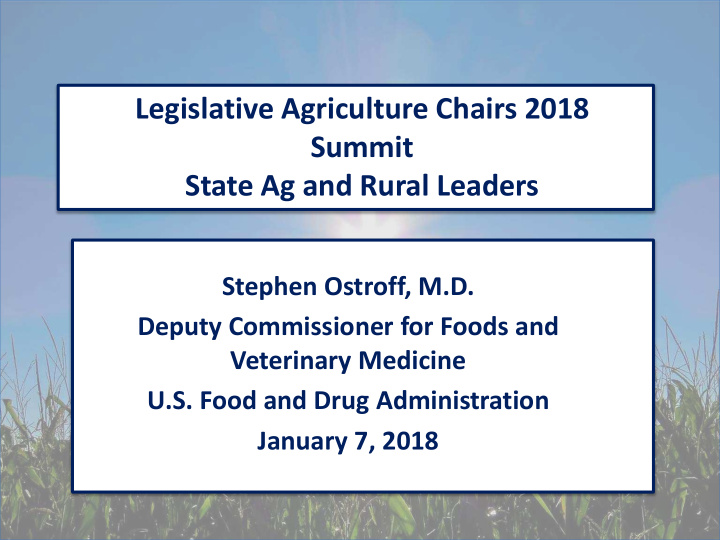



Legislative Agriculture Chairs 2018 Summit State Ag and Rural Leaders Stephen Ostroff, M.D. Deputy Commissioner for Foods and Veterinary Medicine U.S. Food and Drug Administration January 7, 2018
Current Landscape for Food Safety Modernization Act • Much has changed with FSMA since 2016 presentation to SARL by Mike Taylor • Foundational regulations finalized May 2016 • Implementation now underway • Collaboration with federal and state partners • i • Work with state associations (NASDA, ASTHO, AFDO) • Collaborative agreement program (CAP) with states funded for produce safety implementation Sept. 2016
FSMA Compliance Dates • Initial compliance dates – Preventive controls for human food-Sept. 2016 – Preventive controls for animal food-Sept. 2016 – Produce safety rule (sprouts only)-Jan. 2017 – Produce safety rule (non sprouts)-Jan. 2018 – Sanitary transportation- April 2017 – Foreign supplier verification program – May 2017 – Third party accreditation-June 2017 (website) – Intentional adulteration- July 2019
FSMA Implementation • Flexibility built into rules • Educate before & while we regulate • Committed to assist producers to “get it right” – Continued engagement as they implement • Alliance training for all the rules • Initial inspections designed to be “educational” in nature – Unless egregious conditions or violations found • High rates of compliance are crucial for success • Committed to domestic and import parity
Central Wisconsin – Vegetables Oct 2017
Northern Alabama – Cotton Ginning Oct 2017 Northern Alabama
Hawaii – Produce Safety Aug 2017
FSMA “Fixes” • Working to resolve unanticipated issues due to nuances of the law or regulations – Differential treatment of “like” activities – Decrease under-appreciated burdens – Examples: • Packinghouses/holding facilities • Secondary activities farms • Coloring of raw agricultural commodities • Cotton ginning • Certain processing of human food by-products for animal feed – Issued enforcement discretion guidance on Jan 4 • While regulatory solutions put in place
The Produce Safety Rule Science-based standards associated with known routes of contamination of produce: o Agricultural Water o Biological Soil Amendments o Domesticated and Wild Animals o Worker Training and Health and Hygiene o Equipment, Tools, and Buildings
Produce Safety Compliance Dates by Farm Size • Jan 2018 – large farms (>$500k 3-year annual sales) • Jan 2019 – small farms ($250-499k) • Jan 2020 – very small farms ($25-249k)
Exemptions Full Exemptions • Farms with annual sales <$25,000 • Farms that grow for personal or on-farm consumption • Fruits and vegetables rarely consumed raw • Food grains Qualified Exemption • Small or very small farms where • >50% of food sales is produce sold directly to consumers or to restaurants/retail establishments in the same state or within 275 miles of farm • Estimated 47% of covered farms fit this exemption
Next Steps for Implementation of Produce Safety Rule • Biological soil amendments • Agricultural water – Microbial quality standards: too complex to understand and costly to implement – Examine ways to simplify standards while still protecting public health – Proposed earliest compliance date for water: January 2022
FEB FEB. . 27 27-28, 28, 2018 2018 WA WATE TER SUMMIT R SUMMIT RADISSO ISSON N HO HOTEL TEL – CIN INCIN INNATI TI RIVER IVERFR FRON ONT
Next Steps for Implementation of Product Safety Rule (cont.) • Produce inspections – postponed until 2019 • Interim actions in 2018: – Guidance publication – On-Farm Readiness Reviews – Development of farm inventories by states – Training: • Domestic and foreign growers • Inspection workforce – Cooperative Agreement Program
State Produce Implementation CAP Awardees
State Produce Implementation Cooperative Agreement Program (CAP) • Year 1: $21.8 million to 42 states • Year 2: $30.9 million to 43 states • Resources to: – hire staff – education, outreach and technical assistance – Inventory – Inspectional activities • Working with NASDA to bring additional states onboard • FDA will have to conduct activities where states elect not to
Produce Safety Network • FDA produce experts in each region of the country Staff from the Office of Regulatory Affairs and the Center for Food Safety and Applied Nutrition • Outreach, education, and technical assistance • Inspections and outbreak response • Technical Assistance Network for regulators
Dairy Issues • Exports to China • Ultra-Filtered Milk • Automated Milking Systems
Dairy Export Certification Last April, FDA and China signed an MOU to provide U.S. exporters access to the Chinese market for dairy, seafood and infant formula. These commodities require registration when exporting to China. China requires exporters to meet Chinese food safety standards. FDA does not inspect against another authority’s standards. Agreement allows 3 rd parties designated by China to determine if standards are being met; determination provided to FDA. FDA, as the competent food safety authority, maintains and provides the list of U.S. dairly products manufacturers and processors eligible to export to China. List updated and supplied to China quarterly.
Ultra-Filtered Milk Recent changes in export market resulted in oversupply and lower prices for ultra-filtered (UF) milk. U.S. dairy suppliers sought new domestic market opportunities. Use of UF milk authorized for non-standardized cheeses; but not cheeses which have standard of identity. Suppliers asked FDA to use “regulatory discretion” to allow use in standardized cheese without the need to declare on labels. After review, request granted in Aug 2017 for both use and labeling while regulation is being finalized.
Automated Milking Systems • Increasing use – especially on larger dairy farms • At present AMS don’t fully conform to PMO standards • Farms at risk of losing Grade A status due to “unsanitary” equipment • In 2017, FDA took actions to ensure no shipper would lose Grade A status based on use of AMS alone • Actions expire after 2019 NCIMS – Allows time for states, FDA and manufacturers to reach consensus • Internal FDA workgroup focused on AMS; guidance to address questions from states and manufacturers • Work underway with 3-A Sanitary Standards, Inc. involving manufacturers to develop sanitary standards for AMS that would resolve PMO non-conformity 23
Recommend
More recommend